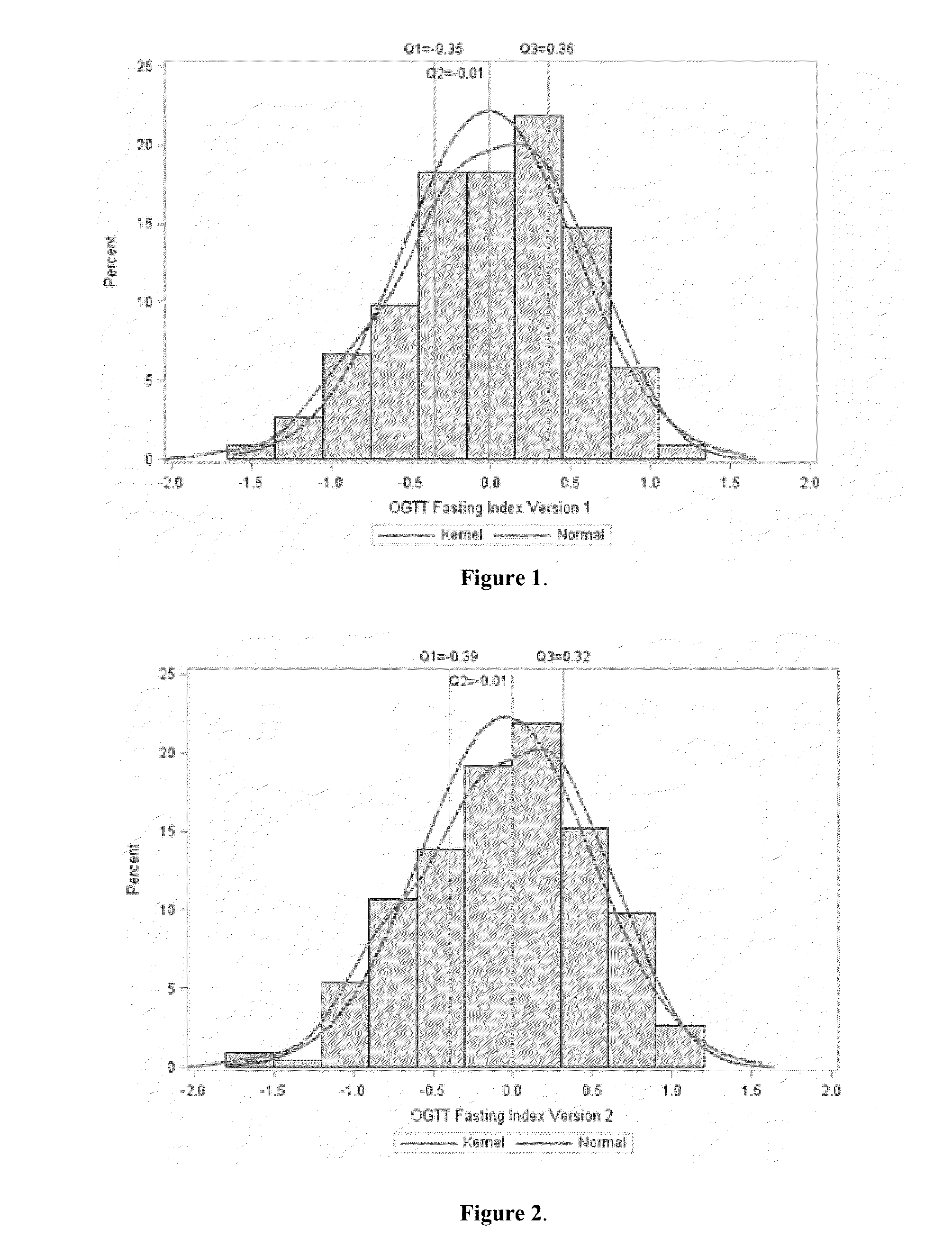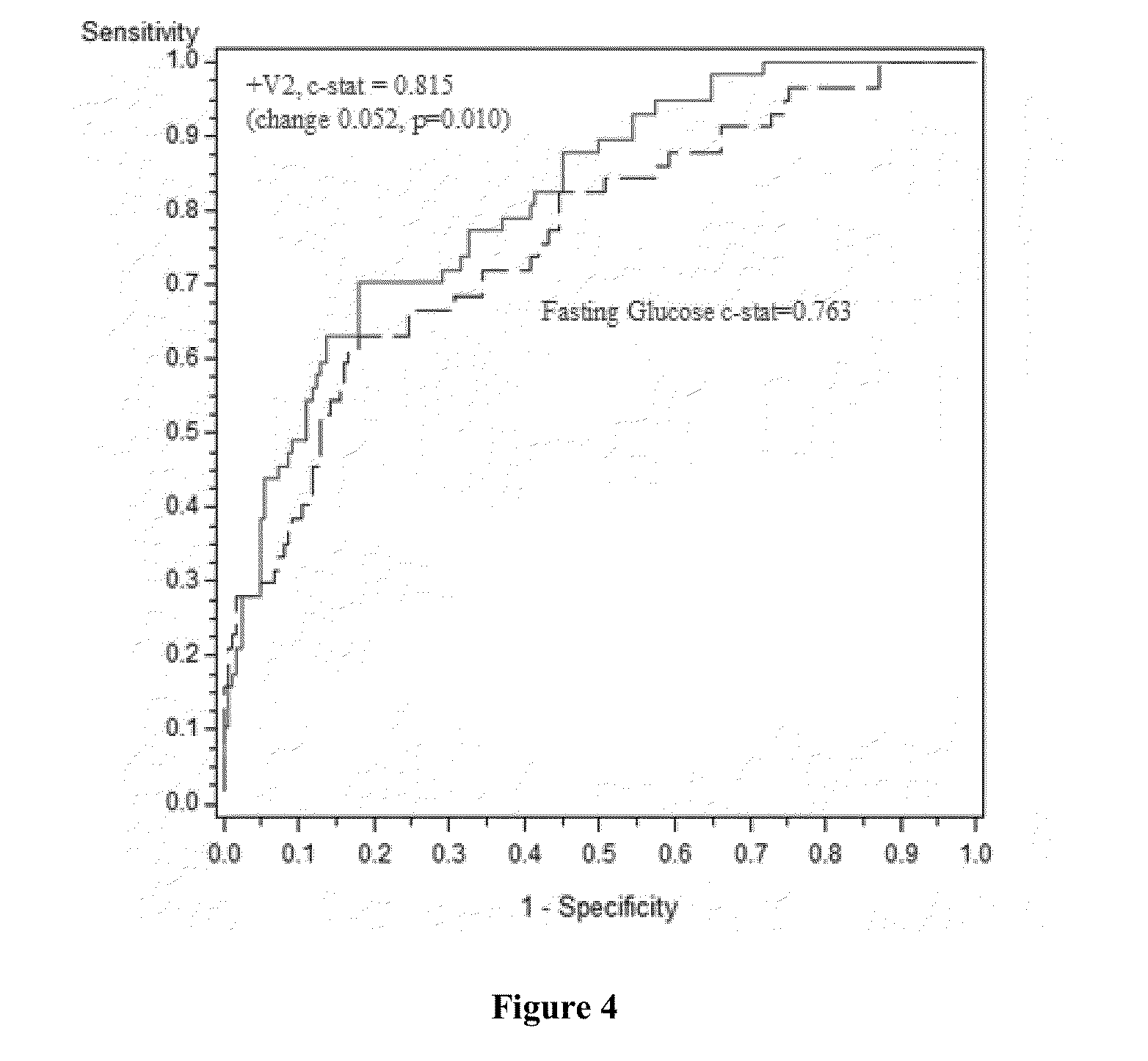METHOD OF DETERMINATION OF RISK OF 2 HOUR BLOOD GLUCOSE EQUAL TO OR GREATER THAN 140 mg/Dl
a blood glucose and risk technology, applied in the field of clinical diagnostics, can solve the problems of complicated and laborious mathematical calculations that need to be performed, and achieve the effect of improving clinical outcomes
- Summary
- Abstract
- Description
- Claims
- Application Information
AI Technical Summary
Benefits of technology
Problems solved by technology
Method used
Image
Examples
example 1
Clinical Study and Statistical Models
[0102]The clinical study included 219 subjects who had not been diagnosed with diabetes, but with one or more of the following clinical indications: obesity, history of first-degree family members with diabetes, and presence of one or more components of the metabolic syndrome including impaired fasting glucose.
[0103]The subjects underwent a 75 g oral glucose tolerance test (OGTT) and fasting blood collection to evaluate risk of diabetes between March 2012 and May 2013 at several outpatient centers across the US (Madison, Wis.; Jackson, Miss.; Montgomery, Ala.; Charleston, S.C.; Seattle, Wash.; and Salt Lake City, Utah). The clinical indications for testing Patients who tested positive for Anti-GAD autoantibody (titer >5 IU / ml) were excluded from this study regardless of T1DM or LADA status. The study protocol was approved by Copernicus Group IRB (NC).
[0104]Samples were sent by overnight courier to Health Diagnostic Laboratory, Inc. ...
example 2
Predicting the Likelihood of Impaired Glucose Tolerance (IGT) Through Combining the Biomarkers of Free Fatty Acid (FFA), C-Peptide, Alpha Hydroxybutyrate (AHB), Ferritin, Linoleoyl-GPC (LGPC), and Adiponectin
[0111]In this example, the OGTT fasting score was calculated combining the measured values for free fatty acid [mmol / L], C-peptide [ng / mL], alpha hydroxybutyrate [μg / mL], ferritin [ng / mL], linoleoyl-GPC [μg / mL], and adiponectin [μg / mL] from a patient sample.
[0112]The samples had previously been analyzed for the values of the area under the curve (AUC) for C-peptide and free fatty acid respectively, which, when multiplied together, strongly correlated with the IGT determined by a 2-hour OGTT.
[0113]The score was calculated according to the following equation (version 1):
Ln[FFA0.774*Cpeptide0.679*AHB0.0655*Ferritin0.0407LGPC0.0848*Adiponectin0.131]
In the equation, the symbols and units of the measured levels are shown as below: Ln=natural logarithm; FFA=free fatty acid [mmol / L]; C-...
example 3
Predicting the Likelihood of Impaired Glucose Tolerance (IGT) Through Combining the Biomarkers of Free Fatty Acid (FFA), C-Peptide, and Adiponectin
[0115]In this example, the OGTT fasting score was calculated combining the measured values for FFA=free fatty acid [mmol / L], C-peptide [ng / mL], and adiponectin [μg / mL] from a patient sample.
[0116]The samples had previously been analyzed for the values of the area under the curve (AUC) for C-peptide and free fatty acid respectively, which, when multiplied together, strongly correlate with the IGT determined by a 2-hour OGTT.
[0117]The score was calculated according to the following equation (version 2):
Ln[FFA0.825*Cpeptide0.729Adiponectin0.137].
[0118]As described in the Statistical Model in Example 1, the exponents for individual biomarkers in the above equation were derived from fitting the above equation to Ln(FFA AUC * C-peptide AUC) by multiple linear regression, and a population study of 10,000 bootstrapped samples, as shown in Table 3...
PUM
| Property | Measurement | Unit |
|---|---|---|
| time | aaaaa | aaaaa |
| time | aaaaa | aaaaa |
| insulin resistance | aaaaa | aaaaa |
Abstract
Description
Claims
Application Information
 Login to View More
Login to View More - R&D
- Intellectual Property
- Life Sciences
- Materials
- Tech Scout
- Unparalleled Data Quality
- Higher Quality Content
- 60% Fewer Hallucinations
Browse by: Latest US Patents, China's latest patents, Technical Efficacy Thesaurus, Application Domain, Technology Topic, Popular Technical Reports.
© 2025 PatSnap. All rights reserved.Legal|Privacy policy|Modern Slavery Act Transparency Statement|Sitemap|About US| Contact US: help@patsnap.com



